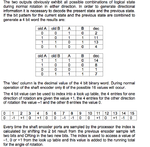shemo
Advanced Member level 4
https://www.sparkfun.com/products/9117
1)If I turn the knob, then the wave form would be output on Pin A and B? but where does the power come from?
2)12 steps mean 12 sectors in one full revolution?
3)old A ,old B, A, B 4 bit word would give 16 values right?
- - - Updated - - -

why there's corresponding table with value of 0, -1 and 1 only?
1)If I turn the knob, then the wave form would be output on Pin A and B? but where does the power come from?
2)12 steps mean 12 sectors in one full revolution?
3)old A ,old B, A, B 4 bit word would give 16 values right?
- - - Updated - - -

why there's corresponding table with value of 0, -1 and 1 only?
